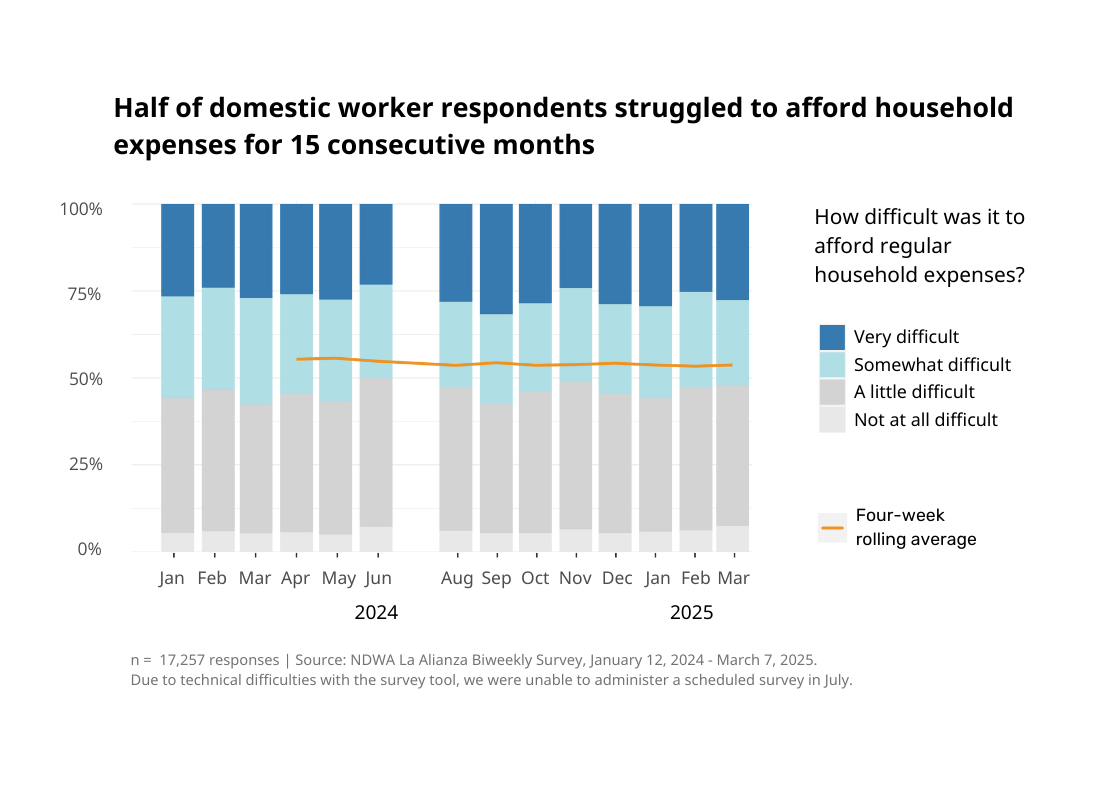La Alianza Domestic Worker Surveys - Quarterly Report
DESPITE IMPROVED WAGES, DOMESTIC WORKERS FACED ECONOMIC INSECURITY IN Q1 2025
May 2025
This report summarizes 2,970 responses to six biweekly surveys among Spanish-speaking domestic workers in Q1 2025. It explores key concerns related to covering basic needs, employment situation, job quality, and working conditions.
ABOUT DOMESTIC WORK
Domestic workers are the nannies, house cleaners, and home care workers that make all other work possible. They care for our children, bring order to our homes, and ensure our loved ones receive the assistance they need to live with dignity and independence in their homes.
Despite their essential contributions to our economy, domestic workers are some of the most vulnerable and marginalized workers. They earn less than the average US worker and are three times as likely to be living in poverty, often relying on several jobs across multiple employers to make ends meet [1].
KEY SURVEY FINDINGS — Q1 2025
The majority of respondents struggled to cover basic needs this quarter
54% found it difficult to afford regular household expenses
81% reported insufficient food at home
50% missed rent or mortgage payments
A plurality of respondents earned between $15-19 per hour. This is $17-$21 below the hourly average of U.S. employees on private, nonfarm payrolls [2], at $36.
Six in ten respondents wanted to work more hours than reported.
Only 30% of respondents had breaks in their workday for eating or resting.
Forty-percent of respondents expressed regular concerns for their health and safety at work.
Thirty percent of respondents reported mistreatment at work.
SURVEY FINDINGS
Basic Needs: Household Expenses
In the first quarter of 2025, 54% of domestic worker respondents reported they found it either very or somewhat difficult to pay for regular household expenses, including food, rent, car payments, and medical expenses. Only 6% said they did not face any difficulty.
These findings are consistent with 2024 estimates, in which an average of 55% of respondents faced difficulty affording basic needs.
Housing
When asked about housing, 43% of domestic worker respondents reported paying their rent or mortgage on-time in the first quarter of 2025. Compared to the 2024 yearly average, the proportion of respondents making timely house payments increased by 3 percentage points.
Food scarcity
Food scarcity, defined as not having enough food “often” or “sometimes”, decreased from 84% in the last quarter of 2024 to 81% in the first quarter of 2025.
The proportion of domestic worker respondents who did not have enough food “often” remained around 16% in both quarters, yet those reporting not having enough food “sometimes” decreased from 68% to 65% in early 2025.
While 81% is the lowest quarterly measure of food scarcity since the start of 2024, about 8 in 10 domestic workers surveyed still face at least some degree of food scarcity.
Employment Situation: Compensation
A plurality of survey respondents earned between $15-19 an hour in the first quarter of 2025, and more than half of all respondents earned $15 or more (56%). As seen below, the overall wage distribution improved in early 2025, indicated by a decrease in the share of respondents earning $9 or less and an increase in those earning $20 or more per hour.
Despite relative improvements compared to recent surveys, a plurality of survey respondents still earn between $17-$21 below the hourly average of U.S. employees on private, nonfarm payrolls [2], at $36.
Workload
The majority of respondents (62%) reported between 1 and 30 work hours per week on average in the first quarter of 2025. Only 21% of respondents reported working 31 hours or more, and 17% reported 0 hours of work.
When asked about their workload, 61% of respondents said they wanted to work more hours but were impeded by:
Challenges finding new clients (66%)
Health problems (13%)
Caring for family members (9%)
Other reason (12%)
Job Quality
New survey questions were introduced in the first quarter of 2025 around job quality and working conditions. The seven new questions explored whether domestic workers had written agreements or contracts with employers, paid time off, breaks for meals and rest, and increased rates for overtime hours.
Survey participants were also asked if they experienced health or safety concerns while working, and whether they had been treated unfairly or disrespectfully while working in the preceding three months.
Job quality questions were asked once in the first quarter of 2025 and will be included in future surveys on a quarterly basis. Below are key takeaways from our first set of responses.
Paid time off
In the event that a worker needs a day off to care for themselves or a family member, 56% said they get time off without compensation. About one-quarter (26%) reported not having any time off, 14% reported access to paid sick days, and the remaining 4% responded “I don’t know”.
When examined by domestic work occupation, 32% of home care workers reported having paid sick days, compared to 13% of nannies and 11% of house cleaners. About 3 in 10 house cleaners (29%) had no time off altogether.
Work breaks
Only 30% of domestic worker respondents reported having breaks regularly built into their workday for meals or rest. Forty-two percent reported being able to take breaks “sometimes”, followed by “rarely” (16%) and “never" (12%).
Working environment
When asked if they experienced health or safety concerns while working during the preceding three months, 40% of respondents said they “regularly” felt concerned. Thirty percent “ rarely” felt concerned for their health or safety, followed by 27% not experiencing any concerns, and 2% selecting “I don’t know”.
Examined by domestic work occupation, nearly half (47%) of home care workers and 43% of house cleaners reported regular health and safety concerns. Concerns occurring “rarely” were most commonly reported among nannies (42%).
Domestic workers were also asked if they had been treated unfairly or disrespectfully while working during the same time period. Answer choices included regular mistreatment, rare mistreatment, no mistreatment, and an option for “I don’t know”.
Among all domestic worker respondents, 8% experienced regular mistreatment, 22% rarely experienced mistreatment, 68% never experienced mistreatment, and 3% selected “I don’t know”. When examined by domestic worker occupation, homecare workers were most likely to experience regular mistreatment, accounting for 11% of responses, compared to 9% among house cleaners and 1% among nannies.
ABOUT THE SURVEY
NDWA surveys thousands of Spanish-speaking domestic workers via La Alianza, a Messenger chatbot. The survey is sent every other week excluding office closures. This report includes data from 6 biweekly surveys in the first quarter of 2025. The total number of fully completed surveys, which includes both new and repeated respondents, was 2,970.
Questions about workers’ employment situation are asked biweekly, questions regarding economic security are asked monthly, and questions regarding job quality are asked quarterly. To learn more about NDWA’s La Alianza survey of Spanish-speaking domestic workers, see the methodology section of this report.
Note: This report was last updated to include corrections to our housing findings on July 22, 2025. An earlier version of the report was published on May 29, 2025.
References
1 Economic Policy Institute (2022), Domestic Workers Chartbook
2 U.S. Bureau of Labor Statistics. (2025). Table B-3. Average hourly and weekly earnings of all employees on private nonfarm payrolls by industry sector, seasonally adjusted




